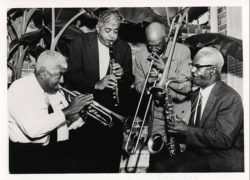Emanuel Paul
Emanuel Paul was a traditional jazz and brass band saxophonist and multi-instrumentalist from New Orleans.

Courtesy of Louisiana State Museum
Percy Humphrey, Willie Humphrey, Albert Warner, and Emanuel Paul. Bennett, Charles F. (Photographer)
Emanuel Paul was a traditional jazz and brass band saxophonist and multi-instrumentalist from New Orleans. Paul is most closely associated with both the Eureka Brass Band and Kid Howard, with whom he would play as a regular member for many years. Along with many other saxophone players who came before him, Paul played a role in encouraging the introduction and acceptance of the saxophone into the New Orleans jazz tradition. Paul is featured in the 1955 film Cinerama Holiday, in which he appears with Papa Celestin at the Old Absinthe House in New Orleans. According to Larry Borenstein and William Russell’s Preservation Hall Portraits, Paul’s solo on the “Westlawn” dirge was one of the most beautiful passages to be heard in a New Orleans jazz funeral at that time.
Paul was born on February 2, 1904, in the Carrollton section of New Orleans. Paul’s first name appears in historical accounts in several different forms, including Emmanuel, Manuel, or Manny. Paul did not begin playing an instrument until age seventeen or eighteen, when he started playing violin in a Broadway Baptist Church youth band. The pastor helped members acquire instruments and arranged tutoring by professional music teachers. Paul taught himself the banjo as well, in order to get more jobs playing for dance gigs. His cousin, James Paul, organized an ensemble that included James on piano and Emanuel on banjo; this group would perform together until 1933. Paul took banjo instruction from Willie Foster in the 1930s (and perhaps later). During this time, Paul also worked at a bank, and like so many other artists of that time, he would be forced to take other odd jobs during the Depression and World War II.
In 1932 and 1933 Paul could be found on clarinet with the George Williams Brass Band. In 1935 Paul played in the Federal Emergency Relief Administration band led by Louis Dumaine, and from 1936 to 1938 he played soprano saxophone in the Works Progress Administration band. Paul purchased an alto sax in 1938 and joined Henry Harding’s ten-piece band. Though he would spend time on guitar as well, the saxophone would become his primary instrument after the Depression. After performing in a trio with the banjoist Albert French and drummer Sam Mossey, Paul joined John Robichaux’s group, with whom he would play through the end of the 1930s. He would switch to tenor sax in 1940.
Around 1940 Paul joined Dominique “T-Boy” Remy’s band, and it was through this group that Paul would come to join the Eureka Brass Band in 1945. Paul was a regular member of Eureka for many years, and often the sound of his tenor sax was used in place of the usual baritone horn. Bill Russell, co-founder of the Hogan Jazz Archive at Tulane University, described Paul as playing tenor sax like a bass or trombone. Paul had begun playing with Kid Thomas in 1943, a musical partnership that would remain strong throughout his career. Over the next decade he recorded a number of times, including with Eureka on the Pax label in 1951 and with Celestin in 1953.
After the opening of Preservation Hall in 1961, Paul became a regular performer at the venue, most often with Kid Thomas’s Algiers Stompers. Paul also recorded a number of times with Thomas, and in the mid-1960s toured Europe and recorded two albums for the European Jazz Macon Club label. These recordings featured Thomas, George Lewis, Butch Thompson, and many other jazz talents. In his oral history interview from April 19, 1960, Paul stated that even though he was a saxophonist, he saw himself as part of the “rhythm section,” a valuable insight into an important aspect of his playing style and aesthetic.
Paul died on May 23, 1988, in New Orleans.
